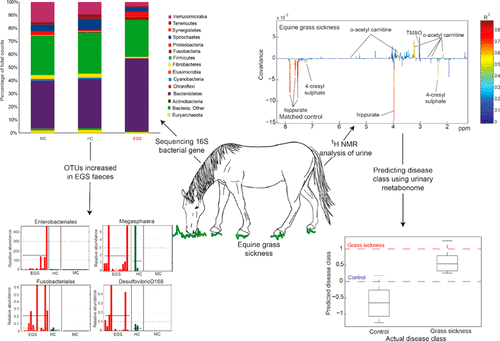当前位置:
X-MOL 学术
›
J. Proteome Res.
›
论文详情
Our official English website, www.x-mol.net, welcomes your feedback! (Note: you will need to create a separate account there.)
Exploration of the Fecal Microbiota and Biomarker Discovery in Equine Grass Sickness
Journal of Proteome Research ( IF 4.4 ) Pub Date : 2018-02-02 00:00:00 , DOI: 10.1021/acs.jproteome.7b00784 Joy Leng 1 , Chris Proudman 1 , Alistair Darby 2 , Frances Blow 2 , Neil Townsend 3 , Andrew Miller 3 , Jonathan Swann 4
Journal of Proteome Research ( IF 4.4 ) Pub Date : 2018-02-02 00:00:00 , DOI: 10.1021/acs.jproteome.7b00784 Joy Leng 1 , Chris Proudman 1 , Alistair Darby 2 , Frances Blow 2 , Neil Townsend 3 , Andrew Miller 3 , Jonathan Swann 4
Affiliation

|
Equine grass sickness (EGS) is a frequently fatal disease of horses, responsible for the death of 1 to 2% of the U.K. horse population annually. The etiology of this disease is currently uncharacterized, although there is evidence it is associated with Clostridium botulinum neurotoxin in the gut. Prevention is currently not possible, and ileal biopsy diagnosis is invasive. The aim of this study was to characterize the fecal microbiota and biofluid metabolic profiles of EGS horses, to further understand the mechanisms underlying this disease, and to identify metabolic biomarkers to aid in diagnosis. Urine, plasma, and feces were collected from horses with EGS, matched controls, and hospital controls. Sequencing the16S rRNA gene of the fecal bacterial population of the study horses found a severe dysbiosis in EGS horses, with an increase in Bacteroidetes and a decrease in Firmicutes bacteria. Metabolic profiling by 1H nuclear magnetic resonance spectroscopy found EGS to be associated with the lower urinary excretion of hippurate and 4-cresyl sulfate and higher excretion of O-acetyl carnitine and trimethylamine-N-oxide. The predictive ability of the complete urinary metabolic signature and using the four discriminatory urinary metabolites to classify horses by disease status was assessed using a second (test) set of horses. The urinary metabolome and a combination of the four candidate biomarkers showed promise in aiding the identification of horses with EGS. Characterization of the metabolic shifts associated with EGS offers the potential of a noninvasive test to aid premortem diagnosis.
中文翻译:

马草病中粪便微生物群和生物标志物发现的探索
马匹草病(EGS)是马匹的一种致命疾病,每年导致英国马匹死亡1至2%。尽管有证据表明该病与肉毒梭菌有关,但目前尚无该病的病因。肠道中的神经毒素。目前尚无法预防,回肠活检诊断是侵入性的。这项研究的目的是表征EGS马的粪便微生物群和生物流体代谢谱,进一步了解该疾病的潜在机制,并鉴定代谢生物标志物以帮助诊断。从具有EGS,匹配的对照和医院对照的马中收集尿液,血浆和粪便。对研究马的粪便细菌种群的16S rRNA基因进行测序后,发现EGS马中存在严重的营养不良,其中拟杆菌的数量增加,而Firmicutes细菌的数量减少。代谢分析1H核磁共振波谱发现EGS与马尿酸盐和4-甲磺酰硫酸的尿排泄量较低以及O-乙酰肉碱和三甲胺-N-氧化物排泄量较高有关。使用第二组(测试)马评估了完整的尿代谢特征以及使用四种区分性尿代谢物按疾病状态对马进行分类的预测能力。尿液代谢组和四种候选生物标志物的组合显示出有望帮助鉴定具有EGS的马匹。与EGS相关的代谢变化的表征提供了一种无创性检测手段来帮助进行死前诊断。
更新日期:2018-02-02
中文翻译:

马草病中粪便微生物群和生物标志物发现的探索
马匹草病(EGS)是马匹的一种致命疾病,每年导致英国马匹死亡1至2%。尽管有证据表明该病与肉毒梭菌有关,但目前尚无该病的病因。肠道中的神经毒素。目前尚无法预防,回肠活检诊断是侵入性的。这项研究的目的是表征EGS马的粪便微生物群和生物流体代谢谱,进一步了解该疾病的潜在机制,并鉴定代谢生物标志物以帮助诊断。从具有EGS,匹配的对照和医院对照的马中收集尿液,血浆和粪便。对研究马的粪便细菌种群的16S rRNA基因进行测序后,发现EGS马中存在严重的营养不良,其中拟杆菌的数量增加,而Firmicutes细菌的数量减少。代谢分析1H核磁共振波谱发现EGS与马尿酸盐和4-甲磺酰硫酸的尿排泄量较低以及O-乙酰肉碱和三甲胺-N-氧化物排泄量较高有关。使用第二组(测试)马评估了完整的尿代谢特征以及使用四种区分性尿代谢物按疾病状态对马进行分类的预测能力。尿液代谢组和四种候选生物标志物的组合显示出有望帮助鉴定具有EGS的马匹。与EGS相关的代谢变化的表征提供了一种无创性检测手段来帮助进行死前诊断。



























 京公网安备 11010802027423号
京公网安备 11010802027423号